Growing Pistachios at home is a rewarding endeavor that allows you to delicious taste of these versatile nuts while enjoying the beauty of a thriving tree in your backyard. Pistachio trees are fascinating and unique plants that have been cultivated for centuries. Pistachio trees make a beautiful addition to any garden with their attractive gray-green foliage and striking red or purple flowers.
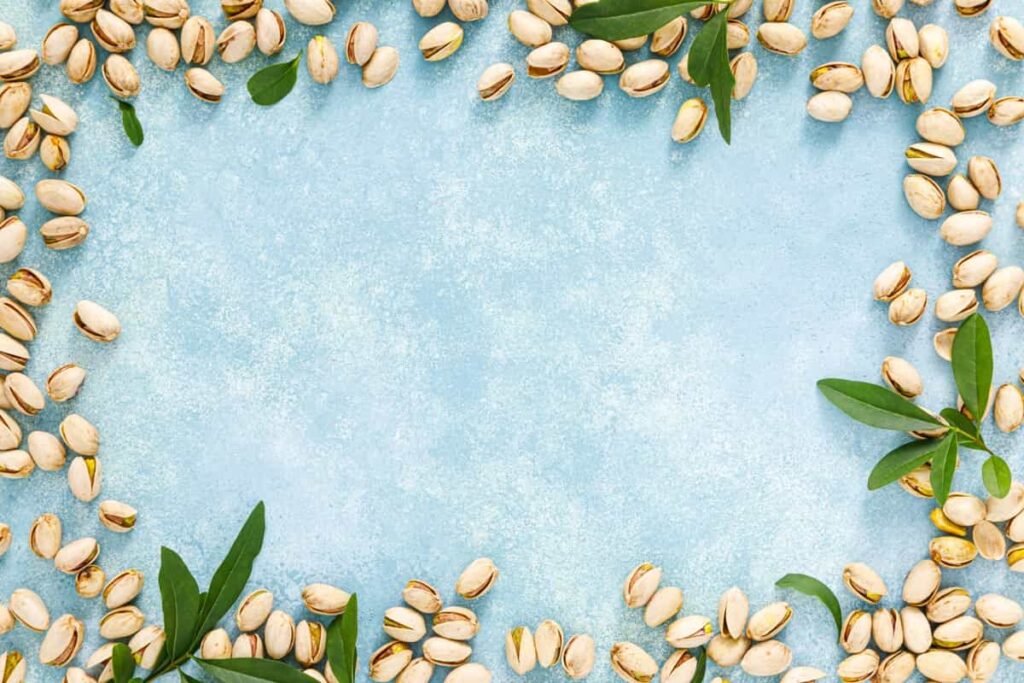
How to Grow Pistachios at Home
Choosing the Right Pistachio Tree Variety for Home Growing
Firstly, think about the climate in your area. Different varieties of Pistachio trees have different temperature requirements, so it’s important to select one suited to your region. Next, think about the size of the tree and how much space you have available in your yard. Some varieties of Pistachio trees can grow quite large, while others are more compact. Consider both height and width when making your decision.
Some popular Pistachio tree varieties include Kerman, Peters, Lost Hills, Golden Hills, and Sirora. For those with limited space or who prefer dwarf varieties, Lost Hills may be the perfect choice. These compact trees reach only about half the size of standard Pistachio trees but still produce abundant crops. Golden Hills is another excellent option for home growers. This self-pollinating variety produces large kernels with a sweet taste and boasts good resistance against diseases.
In case you missed it: How to Grow Olive Trees in Pots: A Comprehensive Guide for Planting and Care
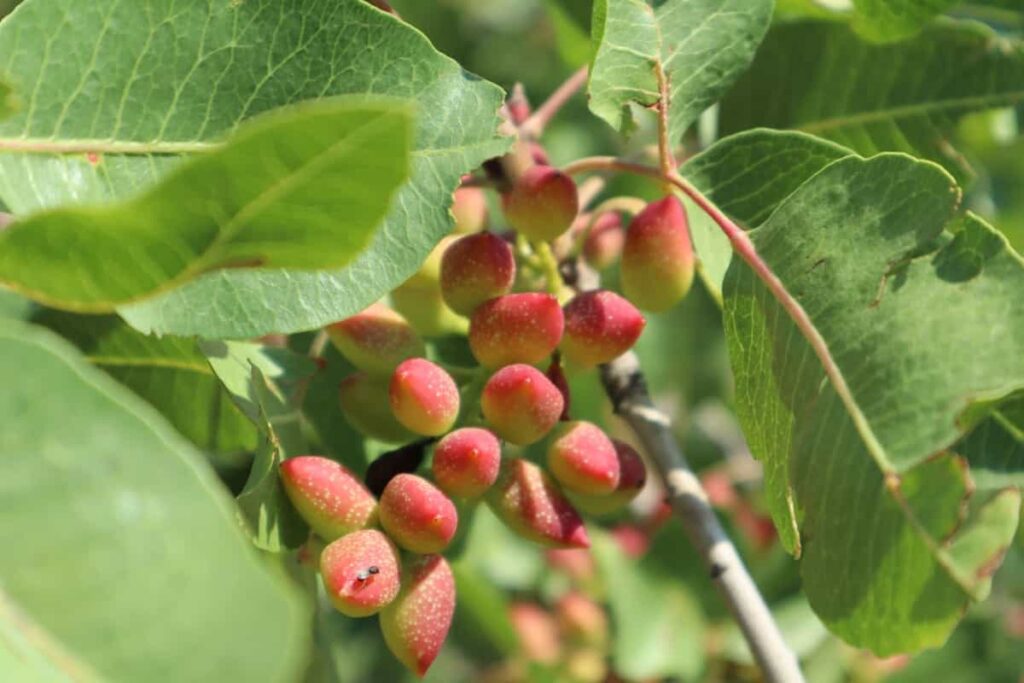
Selecting an Ideal Location for Pistachio Trees
Pistachios thrive in warm climates with long, hot summers and mild winters. They require at least 6 to 8 hours of sunlight daily to ensure proper development. Before choosing a spot for your Pistachio trees, consider the soil conditions. Pistachios prefer well-drained soils that are slightly alkaline with a pH level between 7 and 8. Avoiding areas prone to flooding or waterlogging is important, as this can affect root rot.
Preparing the Soil for Pistachio Tree Planting
Preparing the soil for Pistachio tree planting is essential in ensuring your homegrown Pistachios’ success. Before you start digging, it’s important to assess the composition and condition of your soil. Pistachio trees thrive in well-draining, loamy, or sandy soils with a pH level between 7 and 8. Next, conduct a soil test to determine its nutrient content and make adjustments as necessary. Pistachios require adequate nitrogen, phosphorus, potassium, and micronutrients such as zinc and boron.
Propagating Pistachio Trees through Grafting or Budding Techniques
One of the most effective ways to propagate Pistachio trees is through grafting or budding techniques. Grafting involves joining a scion (a piece of the desired variety) onto a rootstock, creating a union between the two. This technique is commonly used for propagating Pistachios because it allows precise control over the resulting tree’s genetics and quality.
On the other hand, Budding involves inserting a bud from the desired variety into an incision made in the rootstock’s bark. The bud then grows and develops into a new shoot with all the traits of its parent plant. Both grafting and budding require skill and precision to ensure successful propagation. It’s important to select healthy scions and rootstocks and properly match their sizes for optimal compatibility.
How to Grow Pistachio Trees from Seed and Cuttings?
To grow Pistachios from seeds, start by soaking the seeds in water overnight to help break their dormancy. Then, plant them in well-draining soil about 2 inches deep. Keep the soil consistently moist. The seed germination process in Pistachios can take anywhere from a few weeks to several months. Select healthy branches from an established tree during its dormant season if you prefer using cuttings instead of seeds.
In case you missed it: Growing Stages of Onions and Onion Growth Time Lapse
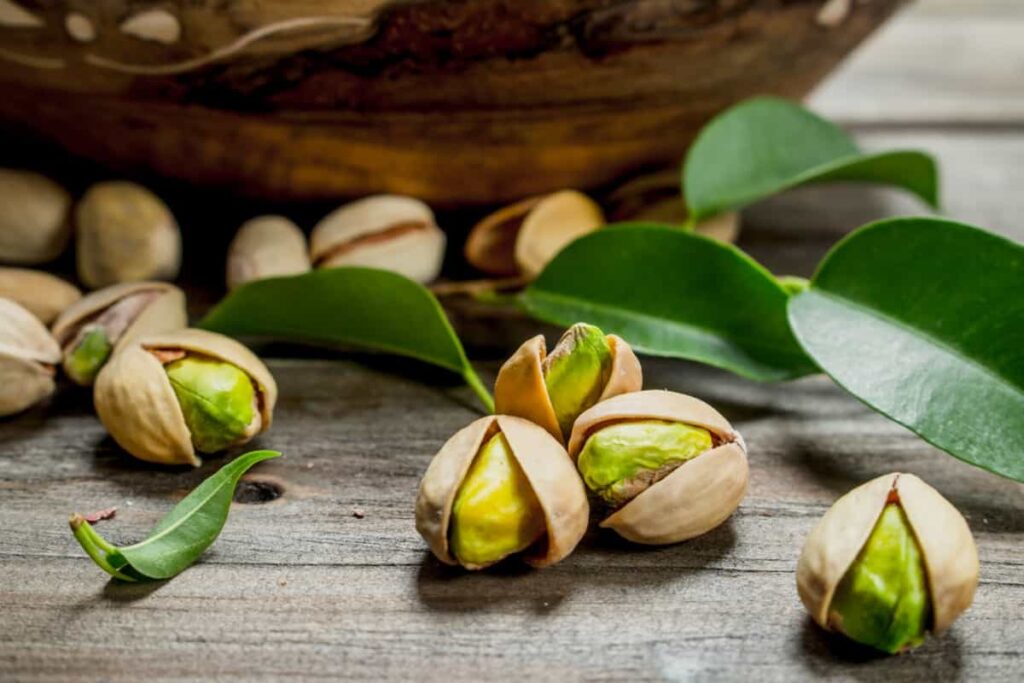
Cuttings should be around 8-12 inches long with at least two nodes present. Dip the cutting of the bottom end into a rooting hormone powder before inserting it into a container filled with potting soil or perlite. Locate the container in a warm location with indirect sunlight and mist regularly to maintain humidity around the cutting. After several weeks, roots should begin to form, indicating successful propagation.
Planting Pistachio Trees from Seeds or Seedlings
You must collect fresh seeds from mature Pistachio trees and soak them in water for about 24 hours before planting. It’s important to note that not all seeds will germinate successfully, so it’s best to plant multiple seeds. On the other hand, if you choose to use seedlings, you can save some time and effort. Seedlings are young plants that have already started growing and can be purchased from nurseries or obtained through grafting techniques. Planting seedlings allows for a more predictable outcome as they are already established.
Whether you choose seeds or seedlings, proper planting techniques are essential for successful growth. Dig a hole large enough for the root system to ensure the bud union is above ground level. Fill the hole with well-draining soil and gently firm it around the roots. Water your newly planted Pistachio tree thoroughly after planting, and continue watering regularly during its first year of growth. This will help establish strong roots for future development.
Providing Adequate Watering for Pistachio Trees
Water is essential for the growth and development of Pistachio trees. Proper watering ensures the trees receive enough moisture to thrive and harvest bountiful. Young trees should be watered deeply during the growing season every 7-10 days, while established trees may only need watering every 2-3 weeks. It’s crucial to monitor soil moisture levels using a moisture meter or by simply digging down into the soil with your finger.
To provide adequate water, use drip irrigation or soaker hoses placed around the base of each tree. This method allows water to penetrate deeply into the soil without wetting the foliage excessively. Providing adequate water at appropriate intervals will ensure healthy growth and maximize yield potential for your homegrown Pistachios.
Fertilizing Pistachio Trees for Optimal Growth
Proper fertilization is essential for the optimal growth and health of Pistachio trees. The right balance of nutrients can significantly impact their overall productivity and yield. When it comes to fertilizing your Pistachio trees, timing is crucial. In the early years, young Pistachio trees require regular fertilization to establish a strong root system. Start by applying a balanced fertilizer with nitrogen, phosphorus, and potassium in the spring before bud break. This will provide an initial boost of nutrients to support healthy growth.
In case you missed it: Idoo Hydroponics Growing System: How to Set Up, Use, and Troubleshoot
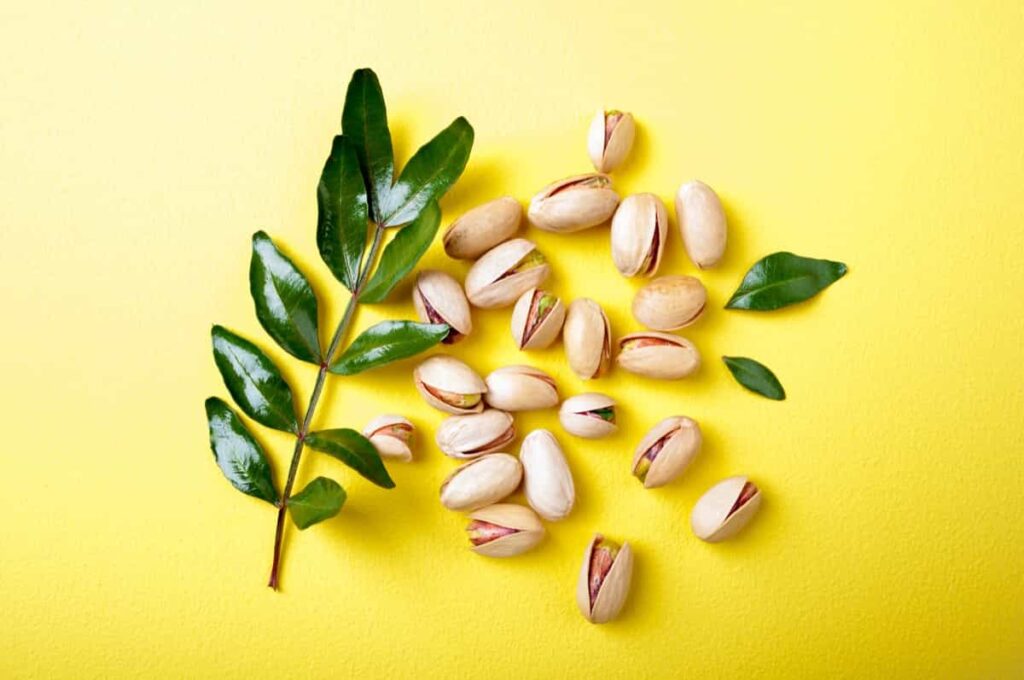
Pruning and Training Pistachio Trees for Shape and Structure
By properly pruning your trees, you not only enhance their overall appearance but also promote better airflow and sunlight penetration, which is crucial for optimal growth. When pruning Pistachio trees, it’s important to start early. Begin by removing any diseased branches, as well as any crossing or rubbing branches that can lead to future damage. It’s also recommended to thin out the canopy by removing excess growth to allow more light into the tree’s center.
Training your Pistachio tree is another important aspect of maintaining its shape and structure. This involves guiding the main trunk upwards while encouraging lateral branching. You can achieve this by using stakes or tying the main stem with a soft cloth or twine. Remember, each tree may require different pruning levels based on its needs and desired shape.
Protecting Pistachio Trees from Pests and Diseases
Firstly, it’s important to identify common pests that affect Pistachio trees. The most notorious culprits include aphids, mites, caterpillars, and beetles. Regularly inspecting your Pistachio trees will help you spot any signs of infestation early on. To combat these intruders, consider implementing natural pest control methods. For example, introducing beneficial insects can help keep pest populations in check by preying on them.
Another effective technique is good cultural management practices such as proper pruning and maintaining tree health through regular fertilization. Healthy trees are better equipped to withstand pest attacks and recover more quickly. Furthermore, organic insecticides or soaps specifically formulated for fruit trees can protect against pesky bugs.
When it comes to diseases that affect Pistachio trees, prevention is key. Good sanitation practices, like removing fallen leaves or debris around the tree’s base, can prevent fungal infections. If you notice any signs of disease infection (such as black spots on leaves), promptly remove affected parts to prevent further spread throughout the tree.
Managing Nutritional Requirements of Pistachio Trees
Nitrogen helps with foliage growth and overall tree vigor. It’s important to provide balanced nitrogen based on the tree’s needs. Phosphorus is another crucial nutrient for Pistachio trees. It plays an important role in root development, flowering, and fruit set. Potassium is also essential for Pistachios as it regulates water movement within the plant and helps with disease resistance.
A potassium deficiency can result in weak branches, poor nut quality, and increased susceptibility to pests. In addition to these primary macronutrients, micronutrients such as magnesium, calcium, zinc, iron, manganese, and copper are also necessary but required in smaller amounts by Pistachio trees. These micronutrients are critical in various metabolic processes contributing to tree health.
Understanding Pollination and Fruit Set in Pistachio Trees
Pollination plays an important role in the fruit set of Pistachio trees. Unlike some other fruits, Pistachios are not self-pollinating, requiring cross-pollination from another variety of Pistachio trees to produce nuts. This process is facilitated by wind and insects. Pistachios have separate male and female flowers on the same tree. The male flowers release pollen that must reach the female flowers’ stigma for successful pollination. Wind is important in carrying pollen from one tree to another, but insects like bees also play a significant role in transferring pollen.
In case you missed it: 17 Honeyberry Varieties: Best Cultivars to Grow in your Garden

To ensure proper pollination, it is recommended to plant at least two different varieties of Pistachio trees within proximity. This encourages cross-pollination and increases the chances of a good fruit set. The timing of pollination is crucial as well. Pistachio trees typically bloom in late winter or early spring before leaves emerge. It’s essential to have compatible varieties blooming simultaneously for effective cross-pollination.
Dealing with Common Issues in Pistachio Tree Growth
One common problem that Pistachio trees may encounter is nutrient deficiency. This can manifest through yellowing leaves or stunted growth. Providing the tree with a balanced nitrogen, phosphorus, and potassium fertilizer is essential to rectify this issue. Another challenge faced by Pistachio trees is pests and diseases.
Regularly inspecting the foliage and prompt treatment with appropriate insecticides or fungicides will help control these issues. Water management also plays a crucial role in Pistachio tree growth. Overwatering the Pistachio plant can lead to root rot, while insufficient watering can cause stress on the plant. Establishing a proper irrigation schedule based on soil moisture levels and weather conditions is vital.
Furthermore, pruning mistakes are often made by novice home growers. Improper or excessive pruning can inhibit fruit production and weaken the tree’s overall structure. Pruning should be done during dormancy periods using sharp tools to ensure clean cuts without causing unnecessary damage.
Extending the Growing Season for Pistachio Trees in Colder Climates
Consider using protective measures such as mulching or wrapping the tree trunk with insulation during winter. This will help to protect the Pistachio roots from frost damage and promote healthier growth come springtime. Additionally, utilizing microclimates within your garden can provide a warmer environment for your Pistachio trees. Placing them near south-facing walls or structures that absorb heat during the day and radiate it at night can create a more favorable growing environment.
Furthermore, row covers or cold frames can protect against frost and freezing temperatures. These structures act as mini-greenhouses, trapping heat inside and shielding your trees from harsh weather conditions. You can move your Pistachio tree indoors when temperatures drop too low outside by planting your Pistachio tree in a large pot or container. Just ensure that it receives sufficient sunlight while indoors to maintain its health.
Harvesting and Storing Pistachios from Homegrown Trees
It is an exciting process that rewards your hard work with delicious, nutritious nuts. Knowing when and how to harvest your Pistachios for optimal flavor and quality is important. When the outer husk of the Pistachio splits open and reveals a fully mature nut inside, it’s time to harvest. This usually occurs in late summer or early fall. To ensure you pick them at the right time, monitor the color change of the hulls as they turn from green to brown.
To remove the nuts from their shells, you can either crack them by hand or use a nutcracker. Some people prefer using their fingers or teeth to enjoy this sensory experience. Once shelled, allow the Pistachios to air dry for several days until they reach a crispy texture. Proper storage is essential for maintaining freshness and preventing spoilage. Store your homegrown Pistachios in an airtight container in a cool, dark place such as a pantry or cellar. Avoid exposing Pistachios to moisture or direct sunlight, leading to mold growth.
Yield of Pistachios per Tree
The yield of Pistachios per tree can vary depending on several factors, such as climate, cultivar variety, and crop management techniques. After 10 to 12 years of budding, when your Pistachio tree is fully developed, you can expect a harvest of around 8 to 10 kilograms per tree. However, it’s important to note that this is just an average estimate, and actual yields may differ based on individual circumstances.
In case you missed it: 15 Best Seed Starting Fertilizers: Homemade, Liquid, and Organic Nutrients for Seedlings Growth
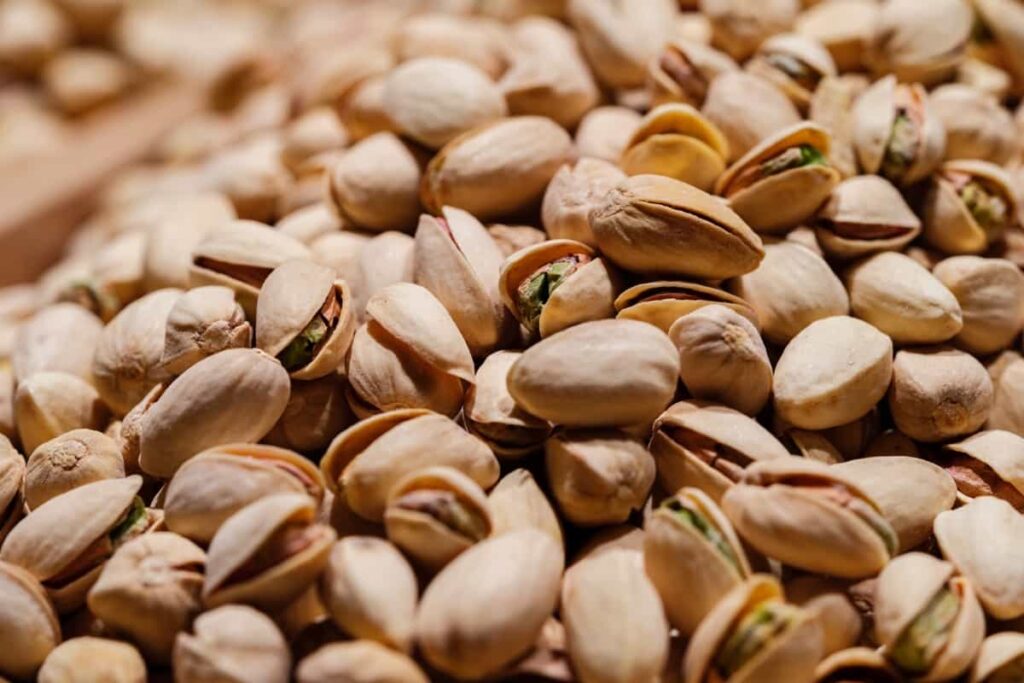
Is It Possible to Grow Pistachios Indoors?
One option for indoor Pistachio growing is dwarf or miniature Pistachio tree varieties specifically bred for container gardening. These trees are more compact and can thrive in limited spaces with proper care. When growing Pistachios indoors, it’s important to provide them with optimal conditions.
They need plenty of sunlight, so place them to use grow lights if necessary. The temperature should also be kept within their preferred range of 21-29°C. Since indoor-grown Pistachio trees won’t experience natural pollination by wind or insects, hand pollination may be required for fruit sets.
Pistachio Tree Growing Zone
Pistachio trees thrive in specific growing zones, and it’s essential to understand these requirements before embarking on your Pistachio-growing journey. The ideal zones for Pistachio tree cultivation are 8, 9, and 10. In zone 4, where temperatures can drop significantly during winter, certain cold-hardy Pistachio cultivars can still flourish. It’s important to research which varieties would be most suitable for your specific region before selecting. Understanding the unique climatic needs of each type will help ensure the successful growth and development of your Pistachio tree.
Conclusion
Understanding the basics of Pistachio tree growth is essential for successful cultivation. These trees thrive in arid climates with long, hot summers and mild winters. They require full sun exposure to produce an abundant harvest of delicious nuts. They thrive in warm climates with long, hot summers and mild winters. While they can be challenging to grow in some regions, with proper care and attention, it is possible to cultivate Pistachios even in colder areas successfully.
- Sheep Farming Business Plan for Beginners
- Aquaponic Farming at Home: A Step-By-Step Guide
- Profitable Village Farming Business Ideas in 2024
- High-Yield Aquaculture: Fast-Growing Fish for Farming
- Effective Fish Pond Construction Techniques for Beginners
- Irrigation and Water Management in Pineapple Farming
- Blossom to Harvest: Mastering Flowering and Pollination in Papaya Farming
- Pig Fattening Essentials: From Selection to Sale for Beginners
- Raising Wagyu Cattle: A Complete Guide for Premium Beef Production
- Soil Types and Their Water Holding Capacity
- Optimizing Irrigation Schedules for Coconut Groves for Enhanced Yield
- Espresso Your Garden: Coffee Grounds for Healthier Acid-Loving Plants
- The Best Soil Mix for Snake Plants: How to Mix Your Own Snake Plant Soil
- Green Thumb Success: Expert Tips for Cultivating Greenhouse Beans All Year Round
- Bloom All Year Round: The Ultimate Guide to Indoor Hyacinth Care
- Eco-Friendly Gardening: How to Make Liquid Fertilizer from Kitchen Waste
- Ultimate Guide to Grow Anise in Pots: Explore Seed Propagation to Harvesting
- Guide to Raising Chester White Pigs: Discover Breed Facts to Growth Management
- Mastering the Elegance: The Ultimate Guide to Weeping Cherry Tree Care, Planting, and Maintenance
- Ultimate Guide to Planting Garlic in Grow Bags: Growing Strategies for Beginners
- How to Fix Spider Plant Leaf-Related Problems: Natural and Organic Remedies
- 10 Reasons Why Your Tulsi Plant is Shedding Leaves: Home Remedies and Solutions
- Optimizing Growth and Yield: The Advantages of Palm Bunch Ash Fertilizer
- Utilizing Neem Oil Extract as a Natural Pesticide for Hydrangea
- From Soil to Harvest: Various Ways in Which Farmers Can Use AI Tools
- Steps to Encourage and Induce Citrus Flowers: A Comprehensive Guide
- How to Fix Snake Plant Leaf-Related Issues: Natural and Organic Remedies
- Transform Your Garden into a Fragrant Oasis with Raat Ki Rani (Night Blooming Jasmine)
- Discover the Ideal Chicken Breeds for Philippine Farms
- How to Create a Poultry Egg Farm Business Plan for Profits
- Grow Lemon Cucumbers Like a Pro: Insider Techniques for Bountiful Yields
- Ultimate Guide to Caring for Your Pink Princess Philodendron: Tips for Thriving Variegation
- Areca Nut Profit Per Acre: Calculating Yield and Cost of Cultivation
- How Kaveri Chicken is Becoming a More Profitable Breed in Indian Backyards
- Transform Your Barn: 9 Steps to Convert a Horse Stall into a Chicken Coop
- Exploring Suffolk Sheep Disadvantages with Limitations and Challenges
